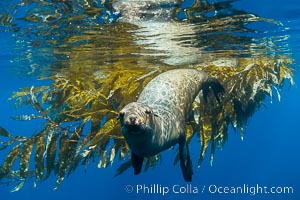
California sea lion on drift kelp paddy, underwater. This adult female California sea lion was hanging out underneath a paddy of drift kelp, well offshore the coastline of San Diego.
Species: California sea lion, Zalophus californianus
Location: San Diego, California
Image ID: 38543
Species: California sea lion, Zalophus californianus
Location: San Diego, California
Image ID: 38543
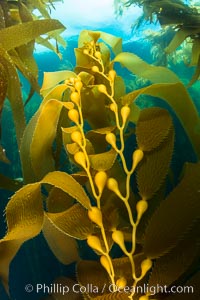
Kelp fronds and pneumatocysts. Pneumatocysts, gas-filled bladders, float the kelp plant off the ocean bottom toward the surface and sunlight, where the leaf-like blades and stipes of the kelp plant grow fastest. Giant kelp can grow up to 2' in a single day given optimal conditions. Epic submarine forests of kelp grow throughout California's Southern Channel Islands.
Location: Catalina Island, California
Image ID: 34166
Location: Catalina Island, California
Image ID: 34166
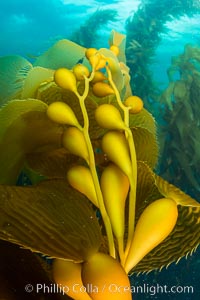
Kelp fronds and pneumatocysts. Pneumatocysts, gas-filled bladders, float the kelp plant off the ocean bottom toward the surface and sunlight, where the leaf-like blades and stipes of the kelp plant grow fastest. Giant kelp can grow up to 2' in a single day given optimal conditions. Epic submarine forests of kelp grow throughout California's Southern Channel Islands.
Location: Catalina Island, California
Image ID: 34167
Location: Catalina Island, California
Image ID: 34167
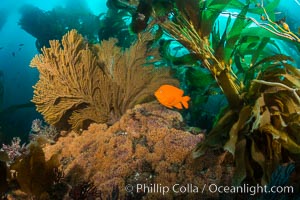
Garibaldi and golden gorgonian, bryozoans, with an underwater forest of giant kelp rising in the background, underwater.
Location: Catalina Island, California
Image ID: 34169
Location: Catalina Island, California
Image ID: 34169
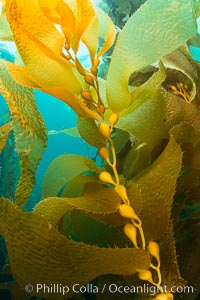
Kelp fronds and pneumatocysts. Pneumatocysts, gas-filled bladders, float the kelp plant off the ocean bottom toward the surface and sunlight, where the leaf-like blades and stipes of the kelp plant grow fastest. Giant kelp can grow up to 2' in a single day given optimal conditions. Epic submarine forests of kelp grow throughout California's Southern Channel Islands.
Location: Catalina Island, California
Image ID: 34173
Location: Catalina Island, California
Image ID: 34173
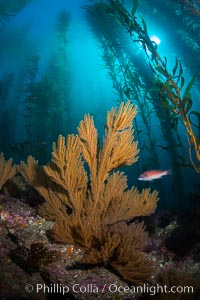
Golden gorgonian on underwater rocky reef, amid kelp forest, Catalina Island. The golden gorgonian is a filter-feeding temperate colonial species that lives on the rocky bottom at depths between 50 to 200 feet deep. Each individual polyp is a distinct animal, together they secrete calcium that forms the structure of the colony. Gorgonians are oriented at right angles to prevailing water currents to capture plankton drifting by.
Species: California golden gorgonian, Muricea californica
Location: Catalina Island, California
Image ID: 34214
Species: California golden gorgonian, Muricea californica
Location: Catalina Island, California
Image ID: 34214
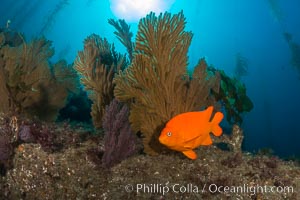
Garibaldi and golden gorgonian, with a underwater forest of giant kelp rising in the background, underwater.
Species: California golden gorgonian, Muricea californica
Location: Catalina Island, California
Image ID: 34216
Species: California golden gorgonian, Muricea californica
Location: Catalina Island, California
Image ID: 34216
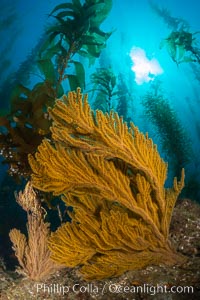
Golden gorgonian on underwater rocky reef, amid kelp forest, Catalina Island. The golden gorgonian is a filter-feeding temperate colonial species that lives on the rocky bottom at depths between 50 to 200 feet deep. Each individual polyp is a distinct animal, together they secrete calcium that forms the structure of the colony. Gorgonians are oriented at right angles to prevailing water currents to capture plankton drifting by.
Species: California golden gorgonian, Muricea californica
Location: Catalina Island, California
Image ID: 34217
Species: California golden gorgonian, Muricea californica
Location: Catalina Island, California
Image ID: 34217
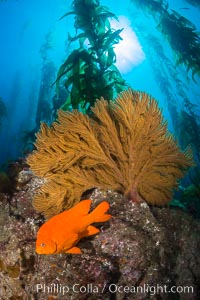
Garibaldi and golden gorgonian, with a underwater forest of giant kelp rising in the background, underwater.
Species: California golden gorgonian, Muricea californica
Location: Catalina Island, California
Image ID: 34218
Species: California golden gorgonian, Muricea californica
Location: Catalina Island, California
Image ID: 34218
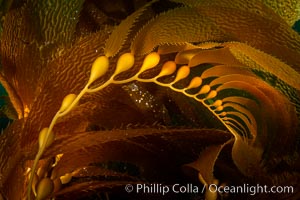
Kelp fronds and pneumatocysts. Pneumatocysts, gas-filled bladders, float the kelp plant off the ocean bottom toward the surface and sunlight, where the leaf-like blades and stipes of the kelp plant grow fastest. Giant kelp can grow up to 2' in a single day given optimal conditions. Epic submarine forests of kelp grow throughout California's Southern Channel Islands.
Species: Giant kelp, Macrocystis pyrifera
Location: San Clemente Island, California
Image ID: 34599
Species: Giant kelp, Macrocystis pyrifera
Location: San Clemente Island, California
Image ID: 34599
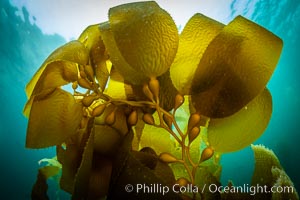
Kelp fronds and pneumatocysts. Pneumatocysts, gas-filled bladders, float the kelp plant off the ocean bottom toward the surface and sunlight, where the leaf-like blades and stipes of the kelp plant grow fastest. Giant kelp can grow up to 2' in a single day given optimal conditions. Epic submarine forests of kelp grow throughout California's Southern Channel Islands.
Species: Giant kelp, Macrocystis pyrifera
Location: San Clemente Island, California
Image ID: 34600
Species: Giant kelp, Macrocystis pyrifera
Location: San Clemente Island, California
Image ID: 34600
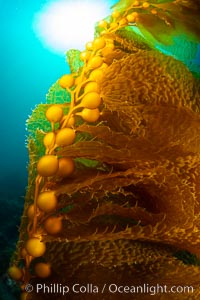
Kelp fronds and pneumatocysts. Pneumatocysts, gas-filled bladders, float the kelp plant off the ocean bottom toward the surface and sunlight, where the leaf-like blades and stipes of the kelp plant grow fastest. Giant kelp can grow up to 2' in a single day given optimal conditions. Epic submarine forests of kelp grow throughout California's Southern Channel Islands.
Species: Giant kelp, Macrocystis pyrifera
Location: San Clemente Island, California
Image ID: 34601
Species: Giant kelp, Macrocystis pyrifera
Location: San Clemente Island, California
Image ID: 34601
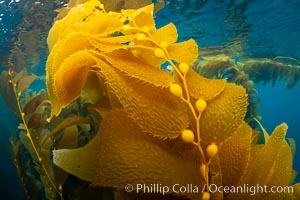
Kelp fronds and pneumatocysts. Pneumatocysts, gas-filled bladders, float the kelp plant off the ocean bottom toward the surface and sunlight, where the leaf-like blades and stipes of the kelp plant grow fastest. Giant kelp can grow up to 2' in a single day given optimal conditions. Epic submarine forests of kelp grow throughout California's Southern Channel Islands.
Species: Giant kelp, Macrocystis pyrifera
Location: San Clemente Island, California
Image ID: 34602
Species: Giant kelp, Macrocystis pyrifera
Location: San Clemente Island, California
Image ID: 34602
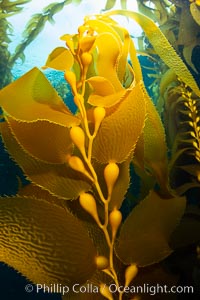
Kelp fronds and pneumatocysts. Pneumatocysts, gas-filled bladders, float the kelp plant off the ocean bottom toward the surface and sunlight, where the leaf-like blades and stipes of the kelp plant grow fastest. Giant kelp can grow up to 2' in a single day given optimal conditions. Epic submarine forests of kelp grow throughout California's Southern Channel Islands.
Species: Giant kelp, Macrocystis pyrifera
Location: San Clemente Island, California
Image ID: 34603
Species: Giant kelp, Macrocystis pyrifera
Location: San Clemente Island, California
Image ID: 34603
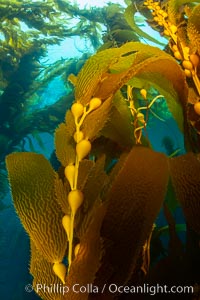
Kelp fronds and pneumatocysts. Pneumatocysts, gas-filled bladders, float the kelp plant off the ocean bottom toward the surface and sunlight, where the leaf-like blades and stipes of the kelp plant grow fastest. Giant kelp can grow up to 2' in a single day given optimal conditions. Epic submarine forests of kelp grow throughout California's Southern Channel Islands.
Species: Giant kelp, Macrocystis pyrifera
Location: San Clemente Island, California
Image ID: 34604
Species: Giant kelp, Macrocystis pyrifera
Location: San Clemente Island, California
Image ID: 34604
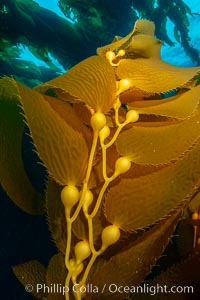
Kelp fronds and pneumatocysts. Pneumatocysts, gas-filled bladders, float the kelp plant off the ocean bottom toward the surface and sunlight, where the leaf-like blades and stipes of the kelp plant grow fastest. Giant kelp can grow up to 2' in a single day given optimal conditions. Epic submarine forests of kelp grow throughout California's Southern Channel Islands.
Species: Giant kelp, Macrocystis pyrifera
Location: San Clemente Island, California
Image ID: 34605
Species: Giant kelp, Macrocystis pyrifera
Location: San Clemente Island, California
Image ID: 34605
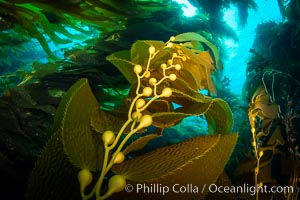
Kelp fronds and pneumatocysts. Pneumatocysts, gas-filled bladders, float the kelp plant off the ocean bottom toward the surface and sunlight, where the leaf-like blades and stipes of the kelp plant grow fastest. Giant kelp can grow up to 2' in a single day given optimal conditions. Epic submarine forests of kelp grow throughout California's Southern Channel Islands.
Species: Giant kelp, Macrocystis pyrifera
Location: San Clemente Island, California
Image ID: 34606
Species: Giant kelp, Macrocystis pyrifera
Location: San Clemente Island, California
Image ID: 34606
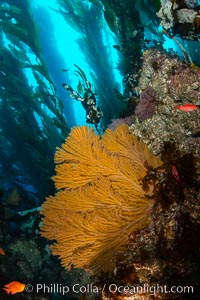
California golden gorgonian on underwater rocky reef, Catalina Island. The golden gorgonian is a filter-feeding temperate colonial species that lives on the rocky bottom at depths between 50 to 200 feet deep. Each individual polyp is a distinct animal, together they secrete calcium that forms the structure of the colony. Gorgonians are oriented at right angles to prevailing water currents to capture plankton drifting by. Catalina Island, California, USA.
Species: California golden gorgonian, Muricea californica
Location: Catalina Island, California
Image ID: 34622
Species: California golden gorgonian, Muricea californica
Location: Catalina Island, California
Image ID: 34622
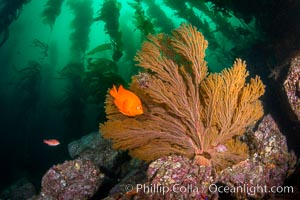
California golden gorgonian on underwater rocky reef, Catalina Island. The golden gorgonian is a filter-feeding temperate colonial species that lives on the rocky bottom at depths between 50 to 200 feet deep. Each individual polyp is a distinct animal, together they secrete calcium that forms the structure of the colony. Gorgonians are oriented at right angles to prevailing water currents to capture plankton drifting by. Catalina Island, California, USA.
Species: California golden gorgonian, Muricea californica
Location: Catalina Island, California
Image ID: 34624
Species: California golden gorgonian, Muricea californica
Location: Catalina Island, California
Image ID: 34624
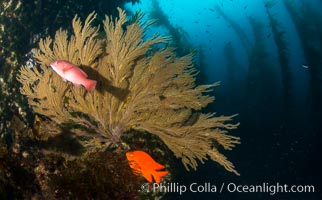
California golden gorgonian, Garibaldi and Sheephead wrasse fishes on rocky reef, below kelp forest, underwater. The golden gorgonian is a filter-feeding temperate colonial species that lives on the rocky bottom at depths between 50 to 200 feet deep. Each individual polyp is a distinct animal, together they secrete calcium that forms the structure of the colony. Gorgonians are oriented at right angles to prevailing water currents to capture plankton drifting by.
Species: California golden gorgonian, California sheephead wrasse, Garibaldi, Hypsypops rubicundus, Muricea californica, Semicossyphus pulcher
Location: San Clemente Island, California
Image ID: 30922
Species: California golden gorgonian, California sheephead wrasse, Garibaldi, Hypsypops rubicundus, Muricea californica, Semicossyphus pulcher
Location: San Clemente Island, California
Image ID: 30922
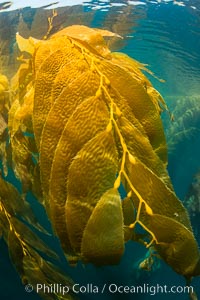
The Kelp Forest offshore of La Jolla, California. A kelp forest. Giant kelp grows rapidly, up to 2' per day, from the rocky reef on the ocean bottom to which it is anchored, toward the ocean surface where it spreads to form a thick canopy. Myriad species of fishes, mammals and invertebrates form a rich community in the kelp forest. Lush forests of kelp are found throughout California's Southern Channel Islands.
Species: Giant kelp, Macrocystis pyrifera
Location: La Jolla, California
Image ID: 30989
Species: Giant kelp, Macrocystis pyrifera
Location: La Jolla, California
Image ID: 30989
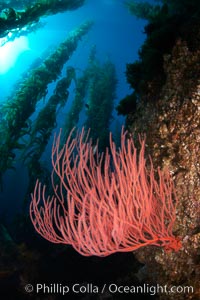
Red gorgonian on rocky reef, below kelp forest, underwater. The red gorgonian is a filter-feeding temperate colonial species that lives on the rocky bottom at depths between 50 to 200 feet deep. Gorgonians are oriented at right angles to prevailing water currents to capture plankton drifting by.
Species: Red gorgonian, Leptogorgia chilensis, Lophogorgia chilensis, Macrocystis pyrifera
Location: San Clemente Island, California
Image ID: 23420
Species: Red gorgonian, Leptogorgia chilensis, Lophogorgia chilensis, Macrocystis pyrifera
Location: San Clemente Island, California
Image ID: 23420
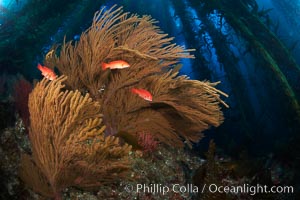
California golden gorgonian and small juvenile sheephead fishes on rocky reef, below kelp forest, underwater. The golden gorgonian is a filter-feeding temperate colonial species that lives on the rocky bottom at depths between 50 to 200 feet deep. Each individual polyp is a distinct animal, together they secrete calcium that forms the structure of the colony. Gorgonians are oriented at right angles to prevailing water currents to capture plankton drifting by.
Species: California golden gorgonian, Muricea californica, Semicossyphus pulcher
Location: San Clemente Island, California
Image ID: 23421
Species: California golden gorgonian, Muricea californica, Semicossyphus pulcher
Location: San Clemente Island, California
Image ID: 23421
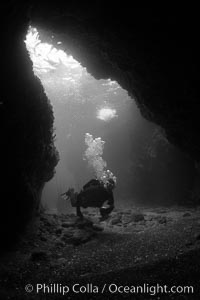
A SCUBA diver enters a submarine cavern at Santa Barbara Island, underwater cave.
Location: Santa Barbara Island, California
Image ID: 23423
Location: Santa Barbara Island, California
Image ID: 23423
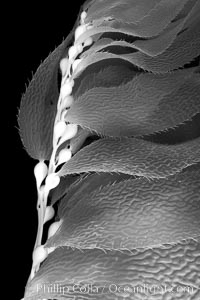
Kelp fronds and pneumatocysts. Pneumatocysts, gas-filled bladders, float the kelp plant off the ocean bottom toward the surface and sunlight, where the leaf-like blades and stipes of the kelp plant grow fastest. Giant kelp can grow up to 2' in a single day given optimal conditions. Epic submarine forests of kelp grow throughout California's Southern Channel Islands.
Species: Giant kelp, Macrocystis pyrifera
Location: San Clemente Island, California
Image ID: 23424
Species: Giant kelp, Macrocystis pyrifera
Location: San Clemente Island, California
Image ID: 23424
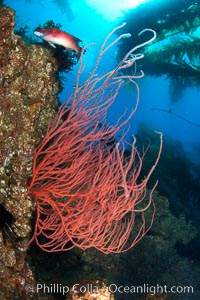
Red gorgonian on rocky reef, below kelp forest, underwater. The red gorgonian is a filter-feeding temperate colonial species that lives on the rocky bottom at depths between 50 to 200 feet deep. Gorgonians are oriented at right angles to prevailing water currents to capture plankton drifting by.
Species: Red gorgonian, Leptogorgia chilensis, Lophogorgia chilensis
Location: San Clemente Island, California
Image ID: 23425
Species: Red gorgonian, Leptogorgia chilensis, Lophogorgia chilensis
Location: San Clemente Island, California
Image ID: 23425
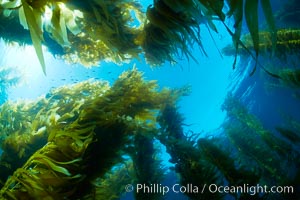
Giant kelp plants lean over in ocean currents, underwater. Individual kelp plants grow from the rocky reef, to which they are attached, up to the ocean surface and form a vibrant community in which fishes, mammals and invertebrates thrive.
Species: Giant kelp, Macrocystis pyrifera
Location: San Clemente Island, California
Image ID: 23426
Species: Giant kelp, Macrocystis pyrifera
Location: San Clemente Island, California
Image ID: 23426
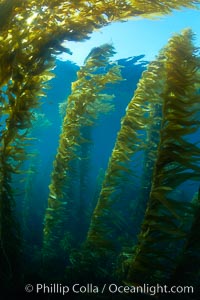
A kelp forest. Giant kelp grows rapidly, up to 2' per day, from the rocky reef on the ocean bottom to which it is anchored, toward the ocean surface where it spreads to form a thick canopy. Myriad species of fishes, mammals and invertebrates form a rich community in the kelp forest. Lush forests of kelp are found through California's Southern Channel Islands.
Species: Giant kelp, Macrocystis pyrifera
Location: San Clemente Island, California
Image ID: 23428
Species: Giant kelp, Macrocystis pyrifera
Location: San Clemente Island, California
Image ID: 23428
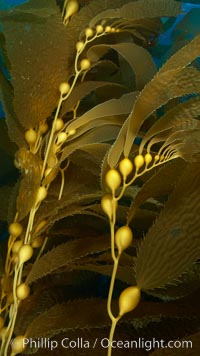
Kelp fronds and pneumatocysts. Pneumatocysts, gas-filled bladders, float the kelp plant off the ocean bottom toward the surface and sunlight, where the leaf-like blades and stipes of the kelp plant grow fastest. Giant kelp can grow up to 2' in a single day given optimal conditions. Epic submarine forests of kelp grow throughout California's Southern Channel Islands.
Species: Giant kelp, Macrocystis pyrifera
Location: San Clemente Island, California
Image ID: 23430
Species: Giant kelp, Macrocystis pyrifera
Location: San Clemente Island, California
Image ID: 23430
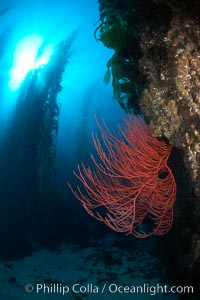
Red gorgonian on rocky reef, below kelp forest, underwater. The red gorgonian is a filter-feeding temperate colonial species that lives on the rocky bottom at depths between 50 to 200 feet deep. Gorgonians are oriented at right angles to prevailing water currents to capture plankton drifting by.
Species: Red gorgonian, Leptogorgia chilensis, Lophogorgia chilensis, Macrocystis pyrifera
Location: San Clemente Island, California
Image ID: 23431
Species: Red gorgonian, Leptogorgia chilensis, Lophogorgia chilensis, Macrocystis pyrifera
Location: San Clemente Island, California
Image ID: 23431